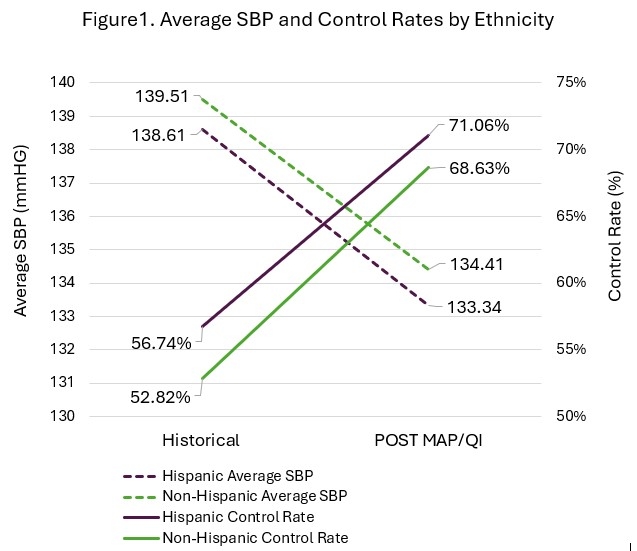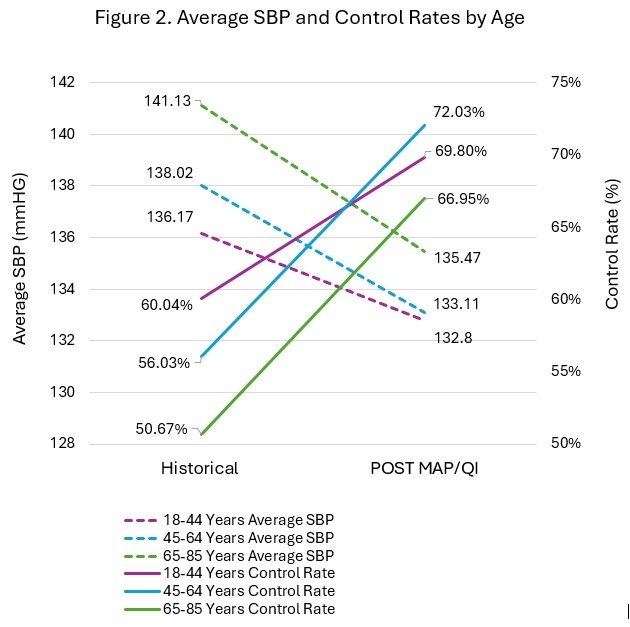Final ID: P-326
Measuring Health Equity Gaps for a Blood Pressure Control Quality Improvement Program: Results from Cook County Health
Abstract Body: Background
High blood pressure (BP) affects nearly half of U.S. adult population and was responsible for 13.0 deaths per 100,000 in 2022, with significant differences in age-adjusted mortality rates by sex, race, and ethnicity. Previous research has also highlighted that lower BP control rates are more prominent in Hispanic and Non-Hispanic Black patients, and well as those 60 years or older. This study assesses the role of the AMA MAP™ Hypertension quality improvement (QI) program to improve potential inequities in blood pressure control at a large public health care institution.
Methods
18,252 patients diagnosed with hypertension were identified at Cook County Health. BP values were obtained for patients in the 2 -years prior to implementation of the QI program (July 2019 to June 2021) compared to BP in the 2-years after implementation (July 2021 to July 2023). A multivariable logistic regression model of BP control status, paired t-tests, and ANCOVA analyses, stratified by race, ethnicity, sex, and age are conducted to assess SBP and measure the gaps by demographic characteristics.
Results
Prior to the QI program, BP control (<140/<90) was significantly less for Black as compared to White patients (OR 0.82 [0.74-0.92]). The racial difference remained after the program, although it was slightly diminished (OR 0.86 [0.76 – 0.97]). Patients who were older were less likely to have controlled BP prior to the program, but these differences were no longer evident following the QI program. The QI program led to a decline in SBP in all demographic groups, including between ethnicity as shown in Figure 1 (Hispanic: -5.74 [CI:6.19- -5.29] vs Non-Hispanic -4.92 [-5.21- -4.63]), White (-5.96 [CI: -6.45- -5.47]) and Black (-4.80 [CI: -5.11- -4.49]) patients, and by age as shown in Figure 2 between 45-64 years ( -5.79 [CI: -6.12- -5.46] and 65-85 years (-4.31 [CI: -4.68- -3.94]).
Conclusion
The results indicate an overall improvement in BP control and SBP, however, gaps persisted in SBP across ethnicity, race, and certain age groups. Quality improvement coaching and dashboards may support clinical care teams in addressing inequities in patient BP control.
High blood pressure (BP) affects nearly half of U.S. adult population and was responsible for 13.0 deaths per 100,000 in 2022, with significant differences in age-adjusted mortality rates by sex, race, and ethnicity. Previous research has also highlighted that lower BP control rates are more prominent in Hispanic and Non-Hispanic Black patients, and well as those 60 years or older. This study assesses the role of the AMA MAP™ Hypertension quality improvement (QI) program to improve potential inequities in blood pressure control at a large public health care institution.
Methods
18,252 patients diagnosed with hypertension were identified at Cook County Health. BP values were obtained for patients in the 2 -years prior to implementation of the QI program (July 2019 to June 2021) compared to BP in the 2-years after implementation (July 2021 to July 2023). A multivariable logistic regression model of BP control status, paired t-tests, and ANCOVA analyses, stratified by race, ethnicity, sex, and age are conducted to assess SBP and measure the gaps by demographic characteristics.
Results
Prior to the QI program, BP control (<140/<90) was significantly less for Black as compared to White patients (OR 0.82 [0.74-0.92]). The racial difference remained after the program, although it was slightly diminished (OR 0.86 [0.76 – 0.97]). Patients who were older were less likely to have controlled BP prior to the program, but these differences were no longer evident following the QI program. The QI program led to a decline in SBP in all demographic groups, including between ethnicity as shown in Figure 1 (Hispanic: -5.74 [CI:6.19- -5.29] vs Non-Hispanic -4.92 [-5.21- -4.63]), White (-5.96 [CI: -6.45- -5.47]) and Black (-4.80 [CI: -5.11- -4.49]) patients, and by age as shown in Figure 2 between 45-64 years ( -5.79 [CI: -6.12- -5.46] and 65-85 years (-4.31 [CI: -4.68- -3.94]).
Conclusion
The results indicate an overall improvement in BP control and SBP, however, gaps persisted in SBP across ethnicity, race, and certain age groups. Quality improvement coaching and dashboards may support clinical care teams in addressing inequities in patient BP control.
More abstracts on this topic:
A major effect of aprocitentan on albuminuria in patients with resistant hypertension
Weber Michael, Bakris George, Flack John, Gimona Alberto, Narkiewicz Krzysztof, Sassi-sayadi Mouna, Wang Jiguang, Schlaich Markus
A Quarter Century of Cardiovascular Strain: Mortality Trends in Hypertension and Hypertensive Heart Disease Among U.S. Adults Aged 55+Ali Muhammad Faizan, Khan Muhammad, Sharif Aleena, Hossain Mohammad, Ahmad Husnain, Eltawansy Sherif, Faizan Muhammad, Ahmed Ashraf, Abdul Malik Mohammad Hamza Bin, Pahwani Ritesh, Patel Rahul, Mehdi Hassan


